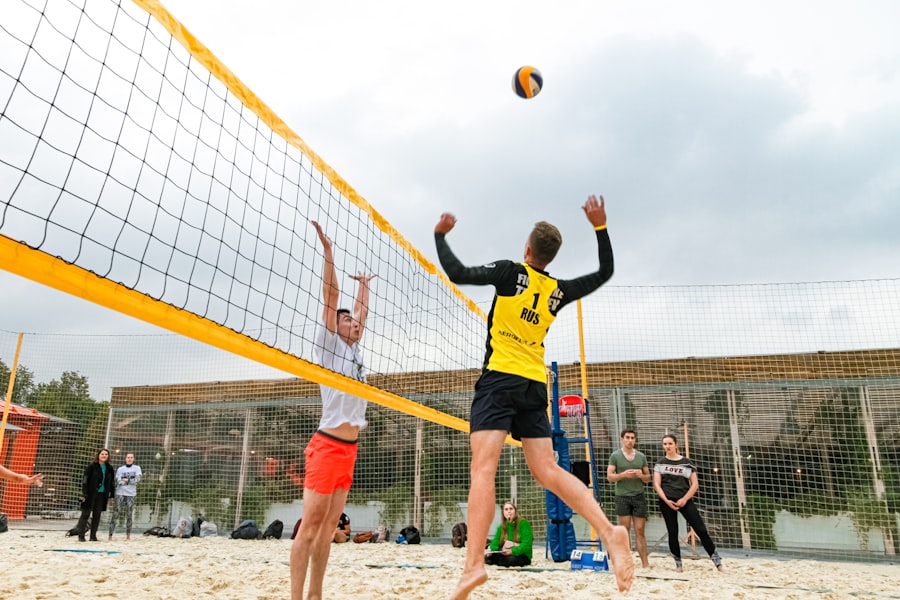Download links
How to install Mastering the Art of Volleyball: Tips for Success APK?
1. Tap the downloaded Mastering the Art of Volleyball: Tips for Success APK file.
2. Touch install.
3. Follow the steps on the screen.
Description
Volleyball is a dynamic and fast-paced sport that has captivated millions around the globe. Originating in the United States in 1895, it has evolved into a highly competitive game played both indoors and on the beach. The fundamental objective of volleyball is simple: two teams, typically consisting of six players each, aim to score points by sending a ball over a net and landing it in the opposing team’s court.
The game is played in sets, with teams needing to reach a predetermined number of points, usually 25, to win a set. Matches are often played in a best-of-five format, adding to the excitement and intensity of the competition. The court dimensions and equipment are crucial to understanding the game.
A standard indoor volleyball court measures 18 meters long and 9 meters wide, divided by a net that stands at a height of 2.43 meters for men and 2.24 meters for women. The ball itself is lightweight, typically weighing between 260 to 280 grams, and is designed for optimal aerodynamics and control. Each team has three hits to return the ball over the net, with players utilizing various techniques such as passing, setting, and spiking to execute plays.
The rotation system ensures that all players participate in both offensive and defensive roles, fostering a well-rounded skill set among team members.
Key Takeaways
- Volleyball is a team sport played with a ball and a net, with the objective of sending the ball over the net and into the opponent’s court.
- Essential skills for success in volleyball include passing, setting, hitting, and serving, which require coordination, agility, and timing.
- Serving and receiving are crucial aspects of volleyball, with serving requiring accuracy and power, and receiving focusing on control and precision.
- Improving defensive techniques involves mastering blocking and digging, while offensive techniques focus on spiking and tipping the ball to score points.
- Teamwork and communication are essential on the volleyball court, with players needing to work together and effectively communicate to achieve success.
- Mental preparation and physical conditioning are key for peak performance in volleyball, with players needing to stay focused, motivated, and physically fit to excel in the sport.
Developing Essential Skills for Success
To excel in volleyball, players must cultivate a diverse array of skills that contribute to both individual performance and team dynamics. One of the most critical skills is passing, which serves as the foundation for successful offensive plays. A well-executed pass allows the setter to deliver an accurate ball to the hitter, setting up scoring opportunities.
Players must learn to position themselves correctly, anticipate the ball’s trajectory, and use their forearms or hands effectively to control the ball. Drills focusing on passing accuracy and consistency can significantly enhance a player’s ability to contribute to their team’s success. Another essential skill is setting, which involves delivering the ball to a hitter in an optimal position for an attack.
A skilled setter must possess excellent hand-eye coordination, quick decision-making abilities, and an understanding of their teammates’ strengths. The setter’s role is often likened to that of a quarterback in football; they must read the defense and make split-second decisions about where to place the ball. Practicing various setting techniques, such as high sets for outside hitters or quick sets for middle blockers, can help develop versatility in this crucial position.
Mastering the Art of Serving and Receiving

Serving is one of the most critical aspects of volleyball, as it initiates each rally and can set the tone for the entire match. There are several types of serves, including underhand, overhand, and jump serves, each requiring different techniques and levels of skill. The overhand serve is particularly popular at higher levels of play due to its potential for power and placement.
Players must focus on their toss, contact point, and follow-through to ensure accuracy and effectiveness. Practicing serves consistently can lead to improved confidence and performance during matches. Receiving serves is equally important, as it directly impacts a team’s ability to transition from defense to offense.
Players must develop strong reception skills to handle various types of serves from opponents. This includes reading the server’s body language, anticipating the ball’s trajectory, and positioning themselves accordingly. Effective communication among teammates during serve reception is vital; players should call for the ball and establish clear roles to avoid confusion.
Drills that simulate different serving scenarios can help players improve their receiving skills and build confidence under pressure.
Improving Defensive and Offensive Techniques
| Technique | Defensive | Offensive |
|---|---|---|
| Footwork | Improves agility and positioning to defend against opponents | Enhances speed and balance for effective attacking |
| Timing | Allows for well-timed blocks and interceptions | Enables precise strikes and counters |
| Decision Making | Helps in choosing the right defensive actions | Assists in selecting the best offensive strategies |
| Anticipation | Anticipating opponent’s moves for better defensive reactions | Predicting opponent’s actions for effective offensive maneuvers |
Defensive techniques in volleyball are essential for thwarting opponents’ attacks and maintaining control of the game. One key defensive skill is digging, which involves successfully receiving an opponent’s spike or hard-driven ball. Players must adopt a low stance with their knees bent and arms ready to react quickly.
Timing is crucial; players need to read the hitter’s approach and anticipate where the ball will go. Practicing digs against various types of attacks can enhance a player’s ability to respond effectively during matches. On the offensive side, spiking is one of the most exciting aspects of volleyball.
To master this technique, players must focus on their approach, jump timing, and arm swing mechanics. The approach typically consists of three steps: a quick shuffle step followed by two powerful steps that generate momentum for jumping.
Timing the jump with the setter’s delivery is crucial; players should aim to make contact with the ball at the highest point possible for maximum power and angle. Regular practice with different sets can help hitters develop their timing and precision.
Teamwork and Communication on the Court
Volleyball is inherently a team sport that relies heavily on effective communication and collaboration among players. Each member of the team has specific roles and responsibilities that contribute to overall success. Establishing clear lines of communication is vital; players should use verbal cues and non-verbal signals to indicate their intentions during plays.
For instance, calling for the ball when receiving serves or signaling for a substitution can prevent misunderstandings that could lead to missed opportunities. Teamwork extends beyond communication; it involves building trust and understanding among teammates. Players must learn each other’s playing styles, strengths, and weaknesses to function cohesively on the court.
Engaging in team-building activities outside of practice can foster camaraderie and improve on-court chemistry. Additionally, regular practice sessions that emphasize cooperative drills can help players develop a sense of unity and shared purpose, ultimately enhancing their performance during matches.
Mental Preparation and Physical Conditioning for Peak Performance

Mental Resilience and Visualization
Techniques such as visualization can be beneficial, allowing athletes to rehearse successful scenarios or visualize themselves overcoming challenges during matches. Additionally, mindfulness practices can help players stay focused and present during high-stakes moments, reducing anxiety and enhancing performance.
Physical Conditioning for Peak Performance
Physical conditioning is equally important for volleyball players aiming for peak performance. The sport demands a combination of strength, agility, endurance, and flexibility. A well-rounded conditioning program should include strength training exercises targeting key muscle groups used in volleyball, such as legs, core, and shoulders. Plyometric exercises can enhance explosive power for jumping and spiking, while agility drills improve quickness on the court. Furthermore, incorporating flexibility training through stretching routines can help prevent injuries and improve overall mobility.
A Comprehensive Approach to Mastering Volleyball
In conclusion, mastering volleyball requires a comprehensive understanding of its fundamentals, development of essential skills, effective teamwork, mental preparation, and physical conditioning. Each aspect contributes significantly to a player’s ability to perform at their best during matches while fostering a positive team environment that encourages growth and success.
If you’re a volleyball enthusiast looking to improve your photography skills, you may want to check out this article on Snapseed here. This photo editing app can help you enhance your volleyball action shots and create stunning visuals. Whether you’re capturing the intensity of a game or the camaraderie of your team, Snapseed offers a variety of tools to take your photos to the next level.
FAQs
What is volleyball?
Volleyball is a team sport in which two teams of six players are separated by a net. The objective is to score points by grounding the ball on the opposing team’s court.
What are the basic rules of volleyball?
The basic rules of volleyball include serving the ball over the net, rallying to keep the ball in play, and trying to score points by grounding the ball on the opposing team’s court. Each team is allowed three touches to return the ball.
What are the different types of volleyball games?
There are several different types of volleyball games, including indoor volleyball, beach volleyball, and sitting volleyball. Each type has its own specific rules and variations.
What equipment is needed to play volleyball?
The main equipment needed to play volleyball includes a volleyball, a net, and appropriate footwear. Players also typically wear knee pads and may use other protective gear.
What are the health benefits of playing volleyball?
Playing volleyball can provide a range of health benefits, including improved cardiovascular fitness, increased strength and agility, and enhanced hand-eye coordination. It also promotes teamwork and social interaction.
What are the key skills needed to play volleyball?
Key skills needed to play volleyball include serving, passing, setting, attacking, and blocking. Players also need good communication and teamwork skills to be successful in the sport.





